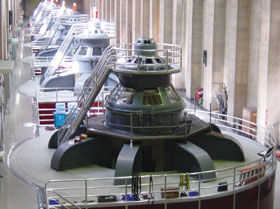

Mechanical vibrations can be detrimental to rotating mechanical components and, in many cases, severely reducing a machine’s operability and longevity. The continuous monitoring of vibrations and other signals is critical to predicting mechanical behaviour and efficiency and usually requires continuous data acquisition and online database analysis.
Veski, a Croatian-based consulting firm that specialises in vibration analysis and diagnostics, relies on LabVIEW and CompactRIO at the core of its CoDiS monitoring software.
Machine monitoring and diagnostics
Online monitoring systems are especially necessary in power production plants where they are used to predict malfunctions and identify irregularities in system performance. These systems can also be used to streamline routine maintenance and prevent long-term and costly damage.
Veski installed CoDiS on more than 30 power generators throughout Croatia and Slovenia and in Lagarfoss, Iceland. Modern industrial monitoring systems typically need features that collect data on vibration, temperature, pressure and flow, while simultaneously maintaining accurate database management. The company designed CoDiS to monitor vibrations of rotors, stator and foundations dynamics, air-gap conditions, electrical exploitation processes, power quality, and hydraulic quantities of large rotating machines. CoDiS is modular and adjustable, and can be designed and customised according to the user’s needs. The entire application is based on LabVIEW, and Veski created and adjusted all analysis and database procedures for customised online monitoring and data acquisition.
The system depends on CompactRIO for simultaneous diagnostic functions and protection and consists of four components: the CoDiS permanent diagnostic monitoring (DM) system, the CoDiS conventional real-time (RT) monitoring for signal and protection systems, and the CoDiS permanent diagnostic rotor monitoring (RM).
System configuration
With CompactRIO and NI FieldPoint, Veski built a highly configurable system and achieved high performance and reliability. CompactRIO is powered by reconfigurable I/O (RIO) FPGA technology and functions simultaneously as a condition monitoring and protection unit.
This monitoring system consists of a measuring component, which includes all sensors and hardware used to acquire data; a signal conditioning component; a CompactRIO processing unit with a personal digital assistant (PDA) local control unit used for data acquisition and analysis; and a central computer that houses a permanent database and analysis procedures for remote LAN users. The system also includes communication with scada systems using analogue or fieldbus output.
In addition, CoDiS includes permanent monitoring and diagnostics of relative shaft vibration, absolute vibration of bearing, axial position of rotor, air gap minimum values, rotor pole magnetic flux, electrical parameters such as current and voltage, phase symmetry, power angle, total harmonic distortion (THD), static and quasistatic parameters, temperatures and process parameters, hydraulic parameters (efficiency, η), and active and reactive power.
Condition monitoring and protection unit installed in high-pressure pumps
The CompactRIO system is configured to monitor relative shaft vibration and rotation speed and provide overspeed protection. The system monitors two hydro-generator units in which each generator set uses CompactRIO as a process unit.
Each monitoring set consists of six displacement sensors used for relative shaft vibration, two displacement sensors used for rotation speed, one NI 9201 module for data acquisition, two NI 9265 analogue output modules for trending of measured signals in scada, one NI 9481 module as an executive part of protection, and an NI cRIO-9002 with an NI cRIO-9101 embedded, reconfigurable chassis.
The CompactRIO system monitors six analogue input signals in volts (three bearings in two axes, X and Y), two analogue input signals in volts (redundant overspeed protection), six analogue current output signals (scada trending), and four relay digital output signals, two for each direction (alarm and trip).
All relevant data, including waveforms and analysis results, are available as shared variables over a shared network. Using NI products, Veski reduced the cost of maintenance and repairs in these power plants by up to 50%.

© Technews Publishing (Pty) Ltd | All Rights Reserved